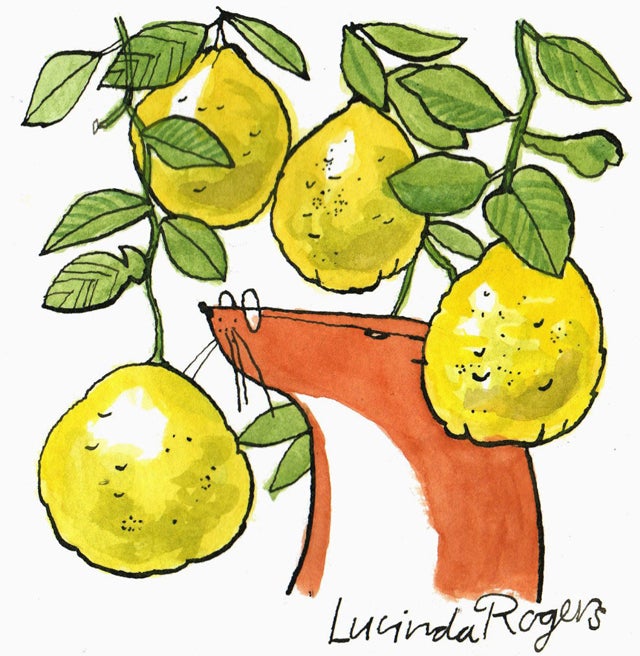The Weasel: Lemon with a twist

Though better known for honeymoons than gastronomy, it was in the Sicilian cliff-top resort of Taormina that I saw one of the most remarkable foodstuffs of my entire life. It happened when Mrs W and I were holidaying there. (No, not a honeymoon.) We were participating in the evening passeggiata on the main drag Corso Umberto when I caught sight of an extraordinary fruit sitting in the window of a restaurant. Barring the size, you would have said it was a lemon. About 10 inches in length, it might have escaped from Gulliver's Brobdingnag. I was smitten. After 10 minutes peering in the window, Mrs W had to drag me away. Its impact was akin to the pineapple that prompted John Murray, the fourth Lord Dunmore, to erect a 53-foot pineapple-shaped pavilion in the grounds of Dunmore Park, Stirlingshire, in 1761. (It's still there. Indeed you can stay in the Pineapple through Landmark Trust.)
I did not build a lemon-shaped folly, but I often mused on this Sicilian curiosity over the years. After a while, the sight seemed so fantastic that I began to wonder if I'd dreamt it up. (Regular readers of this column may not be entirely surprised to learn that food plays a big part in my dream-life.) But the other day, a decade or so after my fleeting encounter, I came across another one. A whole box of them in fact. It happened not in the island of lemons, but in Marylebone, central London. I'd been attending a pickle seminar (as you do) in La Fromagerie on Moxon Street and, as I was dashing out, I caught a glimpse of these astonishing citric giants among a display of vegetables. Soon after, I was the possessor of three of them. The largest weighed exactly 1kg compared to the 112g of an average lemon that I've just weighed. "Blimey!" you might be thinking. "Old Weasel must drink his G&T from a bucket if that's the size of his ice and a slice."
Well, that's just where you're wrong – not about the G&T but the slice. For the fruit I saw in Sicily, and managed to buy 10 years later, was not a lemon, but a close relative called a citron. Though now a rarity, it was once numero uno among citrus. As Gillian Riley informs us in her indispensable Oxford Companion to Italian Food, the citron "may have originated in India, found growing in Persia by Alexander the Great's botanists, and was the first of the citrus fruits to be introduced into Europe." With most citrus, you eat the fruit and chuck away the peel, but it's vice-versa with the citron. Despite its wondrous bulk, the fruit inside tends to be small, dry and dispensable. The peel is the point. It's mainly eaten in candied form. How strange to think that the mighty conqueror of Greece, Persia, Egypt and Mesopotamia was a devotee of the sugary strips we call candied peel. Maybe he should have been known as Alexander the Grater.
La Fromagerie has a weekly delivery of citrons from a grove in Sicily. Lesley, the assistant manager, told me that the raw peel could also be eaten in salads. It goes particularly well with an unusual type of mozzarella called burrata also sold there (as you might have guessed from its name, the shop sells cheese as well as greengrocery). An invention from Apulia, burrata is mozzarella in the shape of a pouch that is filled with fresh cream. You hack it up and consume the delicious cheesy-creamy result. But, as you might imagine, burrata is very time-sensitive. You can't hang about with it. This meant that I had to sacrifice one of my glorious citrons the moment we got home. The peel with its thick white pith proved to be surprisingly good eating – the quintessence of lemon but with its aggressive sourness magically expunged. Dressed with olive oil, it was a perfect companion to the equally exotic cheese.
This Rubenseque beauty of the citrus family not only looks fabulous, it also has the most seductive perfume. Scratch the zest and you're transported by a delectable aroma. They are called cedri in Italian because the fragrance resembles cedars of Lebanon. Unfortunately, my harem of fruit was further diminished when Mrs W snatched one for candying purposes. Incorporated in such treats as lingua di suocera (mother-in-law's tongues) and zuppa inglesi (English soup), this appealing confection is a Sicilian speciality dating from the time of Islamic occupation. At the end of a simmering day, Mrs W presented a box of candied citron to the Vizier of Weasel Villas. He tasted and found it good. A bit too good in fact, for on the following day Mrs W peered into the box and exclaimed: "Oi! There's only two bits left!"
So, my last remaining citron was for the chop. We had some of the peel in another salad (it works pretty well with ordinary mozzarella) and Mrs W candied the rest. She's standing guard over it as I type these words. Though the mystery of the magical fruit I saw in Taormina has now been plumbed, one tantalising aspect remains. Researching the citron on the internet, I discovered a really strange variant called Buddha's hand. You can see it on Google, a citron in the form of a dozen or so long, gnarled fingers. How strange. It's the first time I've known a fruit that actually beckoned ...
Join our commenting forum
Join thought-provoking conversations, follow other Independent readers and see their replies
Comments